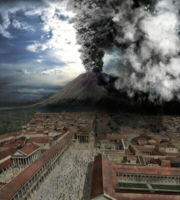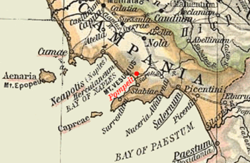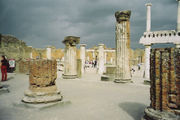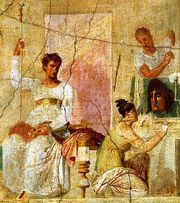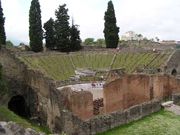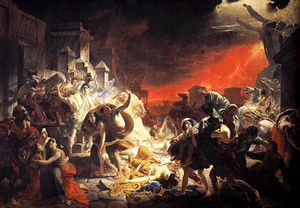Pompeii
2007 Schools Wikipedia Selection. Related subjects: Ancient History, Classical History and Mythology
Pompeii is a ruined Roman city near modern Naples in the Italian region of Campania, in the territory of the commune of Pompei. It was destroyed during a catastrophic eruption of the volcano Mount Vesuvius in AD 79 on August 24th. The volcano buried the city under many feet of ash and it was lost for 1,600 years before its accidental rediscovery. Since then, its excavation has provided an extraordinarily detailed insight into the life of a city at the height of the Roman Empire. Today, it is one of Italy's leading tourist attractions and is a UNESCO World Heritage Site.
Location
The ruins of Pompeii are situated at coordinates , near the modern suburban town of Pompei. It stands on a spur formed by a lava flow to the north of the mouth of the Sarno River (known in ancient times as the Sarnus). Today it is some distance inland, but in ancient times it would have been nearer to the coast.
History
Early history
Although most of the archeological digs at the site only extend down to the street level of the 79 AD volcanic event, deeper digs in older parts of Pompeii and core samples of nearby drillings have exposed layers of jumbled sediment that suggest that the city had suffered from the volcano and other seismic events before then. Three sheets of sediment have been found on top of the lava bedrock that lies below the city and, mixed in with the sediment, archeologists have found bits of mal bone, pottery shards and bits of plants. Using carbon dating, the oldest layer has been placed as 8th-6th century BC, about the time that the city was founded. The other two layers are separated from the other layers by well developed soil layers or Roman pavement and were laid down in the 4th century BC and 2nd century BC. The theory behind the layers of jumbled sediment is large landslides, perhaps triggered by extended rainfall. (Senatore, et al., 2004)
The town was founded around the 6th century BC by the Osci or Oscans, a people of central Italy. It had already been used as a safe port by Greek and Phoenician sailors. When the Etruscans threatened an attack, Pompeii allied with the Greeks, who then dominated the Gulf of Naples. In the 5th century BC, the Samnites conquered it (and all the other towns of Campania); the new rulers imposed their architecture and enlarged the town. It has been supposed that during the Samnites' domination, Rome conquered Pompeii for a while, but these theories have not been verified.
Pompeii took part in the war that the towns of Campania initiated against Rome, but in 89 BC it was besieged by Sulla. Although the troops of the Social League, headed by Lucius Cluentius, helped in resisting the Romans, in 80 BC Pompeii was forced to surrender after the conquest of Nola. It became a Roman colony with the name of Colonia Cornelia Veneria Pompeianorum. The town became an important passage for goods that arrived by sea and had to be sent toward Rome or Southern Italy along the nearby Appian Way.
1st century AD
The excavated town offers a snapshot of Roman life in the 1st century, frozen at the moment it was buried in August 24 AD 79. The Forum, the baths, many houses, and some out-of-town villas like the Villa of the Mysteries remain surprisingly well preserved.
Pompeii was a lively place, and evidence abounds of literally the smallest details of everyday life. For example, on the floor of one of the houses (Sirico's), a famous inscription Salve, lucru (Welcome, money), perhaps humorously intended, shows us a trading company owned by two partners, Sirico and Nummianus (but this could be a nickname, since nummus means coin, money). In other houses, details abound concerning professions and categories, such as for the "laundry" workers (Fullones). Wine jars have been found bearing what is apparently the world's earliest known marketing pun, Vesuvinum (combining Vesuvius and the Latin for wine, vinum). Graffiti carved on the walls shows us real street Latin. In 89 B.C., after the final occupation of the city by Roman General Lucius Cornelius Sulla, Pompeii was finally annexed to the Roman Republic. Under this period, Pompeii underwent a vast process of infrastructural development, most of which, built during the augustan period. Worth noting are an amphitheatre, a Palaestra with a central cella natatoriua or swimming pool, and an aqueduct which covered more than 25 street fountains, more than 4 public baths, and a large number of private houses ( domus) and businesses. The aqueduct branched out through 3 main pipes from the Castelum Aquae, where the waters were collected before being distributed to the city, although it did much more than distribute the waters, it did so with the prerequisite that in the case of gradually extreme drought, the water supply would first fail to reach the Public Baths (least vital service), then private houses and businesses, and when there would be no water flow at all, the system would then at last fail to supply the public fountains (most vital service) in the streets of Pompeii.
The large number of well-preserved frescoes throw a great light on everyday life and have been a major advance in art history of the ancient world, with the innovation of Pompeian Styles the First/Second/Third Style demarcation. Some aspects of the culture were distinctly erotic, including phallic worship. A large collection of erotic votive objects and frescoes were found at Pompeii. Many were removed and kept until recently in a secret collection at the University of Naples.
At the time of the eruption, the town could have had some 20,000 inhabitants, and was located in an area in which Romans had their vacation villas. Prof. William Abbott explains "At the time of the eruption, Pompeii had reached its high point in society as many Romans frequently visited Pompeii on vacations". It is the only ancient town of which the whole topographic structure is known precisely as it was, with no later modifications or additions. It was not distributed on a regular plan as we are used to seeing in Roman towns, due to the difficult terrain. But its streets are straight and laid out in a grid, in the purest Roman tradition; they are laid with polygonal stones, and have houses and shops on both sides of the street. It followed its decumanus and its cardus, centred on the forum.
Besides the forum, many other services were found: the Macellum (great food market), the Pistrinum (mill), the Thermopolium (sort of bar that served cold and hot beverages), and cauporioe (small restaurants). An amphitheatre and 2 theatres have been found, along with a palaestra or gymnasium. A hotel (of 1,000 square metres) was found a short distance from the town; it is now nicknamed the "Grand Hotel Murecine".
In 2002 another important discovery at the mouth of Sarno river revealed that the port also was populated and that people lived in palafittes, within a system of channels that suggested a likeness to Venice to some scientists. These studies are just beginning to produce results.
62-79
The inhabitants of Pompeii, as those of the area today, had long been used to minor tremors (indeed, the writer Pliny the Younger wrote that earth tremors "were not particularly alarming because they are frequent in Campania"), but on 5 February 62 there was a severe earthquake which did considerable damage around the bay and particularly to Pompeii. In the time between 62 and the eruption in 79 AD, some rebuilding was done, but some of the damage had still not been repaired at the time of the eruption .
An important current field of research concerns structures that were being restored at the time of the eruption (presumably damaged during the earthquake of 62). Some of the older, damaged, paintings could have been covered with newer ones, and modern instruments are being used to catch a glimpse of the long hidden frescoes. The probable reason why these structures were still being repaired 10 years after the earthquake was the increasing frequency of smaller quakes that led up to the eruption.
Vesuvius eruption
By the 1st century AD, Pompeii was only one of a number of towns located around the base of Mount Vesuvius. The area had a substantial population which grew prosperous from the region's renowned agricultural fertility. Many of Pompeii's neighboring communities, most famously Herculaneum, also suffered damage or destruction during the 79 AD eruption. The people of Pompeii were covered in up to 12 different layers of soil.
Rediscovery
After thick layers of ash covered the two towns, they were abandoned and eventually their names and locations were forgotten. Then Herculaneum was rediscovered in 1738, and Pompeii in 1748. These towns have since been excavated to reveal many intact buildings and wall paintings. The towns were actually found in 1599 by an architect named Fontana, who was digging a new course for the river Sarno, but it took more than 150 years before a serious campaign was started to unearth them. The king Charles VII of Two Sicilies took great interest in findings even after becoming king of Spain.
Guiseppe Fiorelli took charge of the excavations in 1860. During early excavations of the site, occasional voids in the ash layer had been found that contained human remains. It was Fiorelli who realised these were spaces left by the decomposed bodies and so devised the technique of injecting plaster into them to perfectly recreate the forms of Vesuvius's victims. What resulted were highly accurate and eerie forms of the doomed Pompeiani who failed to escape, in their last moment of life, with the expression of terror often quite clearly visible (see , , )
Some have theorized, without proof, that Fontana initially found some of the famous erotic frescoes and, due to the strict modesty prevalent during his time, reburied them in an attempt at archaeological censorship. This view is bolstered by reports of later excavators who felt that sites they were working on had already been visited and reburied. A detailed discussion of the erotic art of Pompeii, with pictures, can be found in a separate article.
Pompeii Today
In modern times Pompeii has become a popular tourist destination; with approximately 2.5 million visitors a year, it is the most popular tourist attraction in Italy. It is now part of a larger Vesuvius National Park, and was declared a World Heritage Site by UNESCO in 1997. To combat problems associated with tourism, the governing body for Pompeii, the Soprintendenza Archaeological di Pompei have begun issuing new tickets that allow for tourists to also visit cities such as Herculaneum and Stabiae as well as the Villa Poppaea, to encourage visitors to see these sites and reduce the pressures on Pompeii.
Pompeii is also a driving force behind the economy of the nearby town of Pompei. Many residents are employed in the tourism and hospitality business, serving as taxi or bus drivers, waiters or hotel operators. The ruins are only accessible to tourists through the train line to the modern town, or else a private train line that runs directly to the ancient site from Naples.
Excavations in the site have generally ceased due to the moratorium imposed by the superintendent of the site, Professor Pietro Giovanni Guzzo. Additionally, the site is generally less accessible to tourists, with less than a third of all buildings open in the 1960s being available for public viewing today. Nevertheless, the sections of the ancient city open to the public are extensive, and tourists can spend many days exploring the whole site.
Issues of Conservation
When Pompeii was buried under the ash and rubble of Mt. Vesuvius, the objects buried beneath it were remarkably well-preserved for thousands of years. The lack of air and moisture allowed for the objects to remain underground with little to no deterioration, which meant that, once excavated, the site had a wealth of sources and evidence for analysis, giving remarkable detail into the lives of the Pompeiians. Unfortunately, once exposed, Pompeii has been subject to both natural and man-made forces which have rapidly increased their rate of deterioration.
Weathering, erosion, light exposure, water damage, poor methods of excavation and reconstruction, introduced plants and animals, tourism, vandalism and theft have all damaged the site in some way. Today, funding is mostly directed into conservation of the site; however, due to the expanse of Pompeii and the scale of the problems, this is inadequate in halting the slow decay of the materials. An estimated US$335 million is needed for all necessary work on Pompeii.
Pompeii in popular culture
Books
Pompeii served as the background for the historic novels The Last Days of Pompeii (since adapted for film and TV) and Pompeii, as well as appearing in Shadows in Bronze and other novels in the Marcus Didius Falco series.
Book I of the Cambridge Latin Course teaches Latin while telling the story of a Pompeii resident, Lucius Caecilius Iucundus, from the reign of Nero to that of Vespasian. The book ends when Mount Vesuvius erupts, and Caecilius is killed. The books have a cult following and students have been known to go to Pompeii just to track down Caecilius's house.
In Michael Ondaatje's "The English Patient" on page 278 it quotes "He passes the Museo Archeologico Nazionale, where the remnants of Pompeii and Herculaneum are housed. He has seen the ancient dog frozen in white ash."
TV
Fiction
It was the setting for the British comedy television series Up Pompeii, and the film of the series.
Documentaries
More recently;
- an hour-long drama produced for the BBC entitled Pompeii: The Last Day portrayed several characters (with historically attested names, but fictional life-stories) living in Pompeii, Herculaneum and around the Bay of Naples, and their last hours, including a fuller and his wife, two gladiators, and Pliny the Elder. It also portrays the facts of the eruption. However, it is heavily influenced by Edward Bulwer-Lytton's book The Last Days of Pompeii (see above), which — while being responsible for the popularising of Pompeii in Western culture — has been dismissed for its lack of historical credibility.
- Pompeii Live, Channel 5, 28th June 2006, 8pm, live archaeological dig
Music
In October of 1971, the band Pink Floyd performed at the vacant 2,000-year-old amphitheater in Pompeii, to an audience composed of film crew including camera operators. This performance, including some exterior shots of the ruins, was released as part of a movie entitled " Pink Floyd: Live at Pompeii."
Last Days of Pompeii is the 1991 rock opera by alternative rock band Nova Mob.
Pompeii am Götterdämmerung is the name of a song by the band The Flaming Lips on their album " At War With the Mystics". The song narrates the tale of a couple who, in reaction to their families' rejection of their love, commit suicide together by simultaneously jumping into a volcano.
"Pompeii" is the title of a song written by Seattle-based progressive rock band Gatsbys American Dream. It is the second track of their 2005 release, "Volcano" - based loosely around the story of Pompeii.
A musical track of the same name is also produced by E.S. Posthumus and has been used in films like Planet of The Apes and many others, under the Unearthed album. This music is said to be the favorite among the listeners who have the mentioned album due to the dramatic and imposing tempo.
The city of Pompeii is mentioned in the band, The Mars Volta's song, Cicatriz Esp.
Other
The theme park Busch Gardens Europe features an attraction entitled " Escape from Pompeii," which carries riders through the city as flaming ruins topple around them, ending in a fifty-foot plunge.
Rexford (Rex) Phillips, a.k.a. “Rexino Mondo,” wrote, sang, narrated and produced a 210-minute “audio book” entitled Messenger From Pei. It tells of his tour of duty in the U.S. Army’s 10th Special Service Company in Korea, where he encountered, befriended and eventually discovered strong bonds with actress Debbie Reynolds. Unexplainable cross-currents take them on a journey into a past lifetime, and in particular their escape from “decadent Pei,” just prior to that city’s complete destruction, the same as the final days of its corrupted daughter-to-be “Pompeii.” The work was produced in 1992, and had limited circulation.
Siouxsie and The Banshees single 'Cities in Dust'(1985) was also inpired by the destruction of Pompeii.
